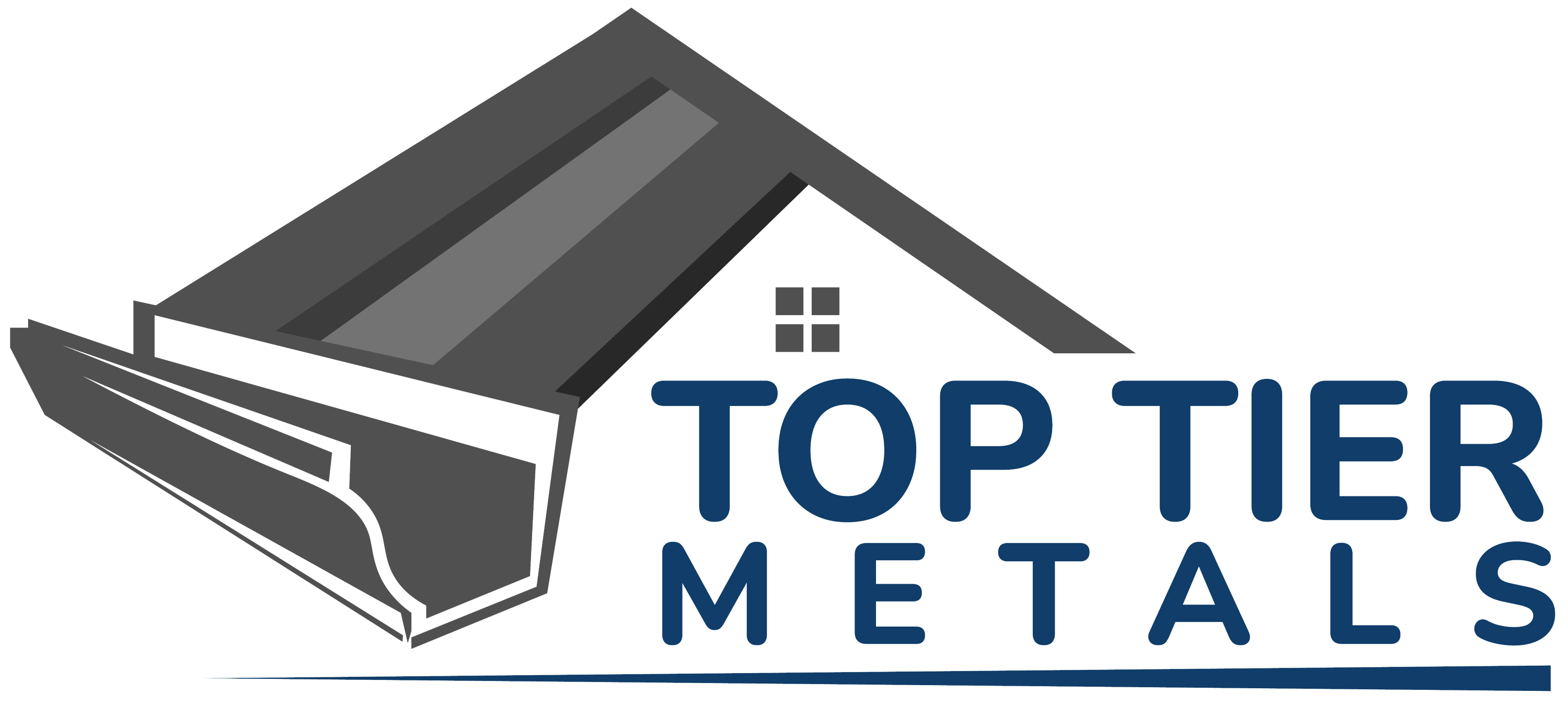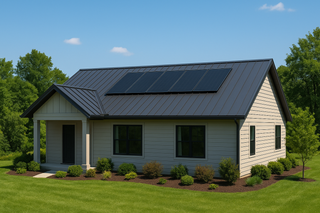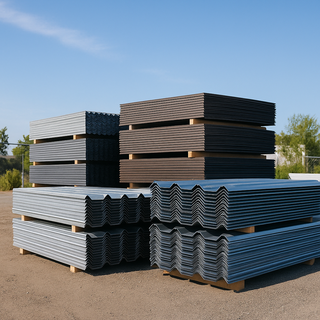Solar power and metal roofing are a natural match — literally. Both are long-term, energy-efficient investments that increase home value, cut utility costs, and reduce environmental impact. But when it comes to integrating solar photovoltaic (PV) systems with metal roofing, details matter.
At Top Tier Metals, we supply homeowners, DIYers, and contractors with premium metal roofing systems that are solar-ready — and this extensive guide explains how to optimize your solar setup for performance, durability, and long-term savings.
1. Why Metal Roofing is the Best Surface for Solar Panels
Compared to asphalt shingles, tile, or flat membrane roofs, metal roofing offers a series of unmatched advantages for solar installations:
Durability & Longevity:
-
Metal roofs last 40–70 years, outlasting most solar panels (typically 25–30 years)
-
No need to remove and reinstall panels halfway through the roof’s lifespan
Mounting Compatibility:
-
Standing seam metal roofs require no penetrations
-
Clamps attach directly to the seams — no drilling, no leaks
Reflectivity & Efficiency:
-
Metal roofs reflect sunlight, reducing attic heat and boosting system efficiency
-
Some reflective coatings help lower panel surface temps, preserving panel lifespan
Lower Total Lifecycle Costs:
-
Fewer roof repairs = less labor and no need to unmount panels
-
Fewer penetrations = lower long-term leak risk and better energy ROI
2. Choosing the Right Metal Roof Profile for Solar Integration
The roof panel profile you select has a major impact on how solar can be installed:
✅ Best Option: Standing Seam Metal Roofing
-
No holes needed — solar panel brackets clamp onto seams
-
Preserves warranty and weather-tightness
-
Clean, flush aesthetic
✅ Good Option: Corrugated or R-Panel (Exposed Fastener)
-
Requires screw-down mounts or strut systems with rubber gaskets
-
Slightly more risk for leaks long-term but still viable
-
Ideal for garages, barns, cabins, and budget installs
Top Tier Tip: Let us know if you plan to install solar — we’ll match you with a panel profile that supports clean, simple integration.
3. What Type of Solar Mounting System Should You Use?
Your mounting system must be compatible with both your roof and your climate. Here are your main options:
For Standing Seam Roofs:
-
S-5! Clamps, EcoFasten, or QuickBOLT products
-
No roof penetrations
-
Clamps are engineered to hold securely in wind, snow, or seismic conditions
For Exposed Fastener Roofs:
-
Lag-mounted brackets with neoprene or butyl sealant washers
-
Flashing boots and sealing tape critical at penetration points
-
Use with caution in high rainfall or freeze/thaw regions
For All Roofs:
-
Consider a rail-less system to reduce weight and installation time
-
Microinverters or power optimizers for shading/flexibility
4. Wiring, Inverters, and Attachment Planning
A good solar system doesn’t just sit on your roof — it has to work with it.
Key Integration Considerations:
-
Run conduit under panels or through attic, not across roof surface
-
Use UV-resistant cable clips to secure wiring
-
For metal roofs, non-corrosive mounts (aluminum or stainless steel) are essential
-
Match inverter placement to available wall space with heat dissipation in mind
Bonus Tip:
For DIYers, consider using plug-and-play microinverters to simplify wiring and optimize each panel independently.
5. Can Solar Be Retrofitted Onto an Existing Metal Roof?
Absolutely — and often with fewer challenges than shingle roofs.
Requirements for Retrofit Success:
-
Roof still in good condition (no rust, separation, or sagging)
-
Access to attic or roof deck for cabling and inverter installation
-
Structural framing strong enough to support panel weight (2–6 lbs/sqft)
Standing seam roofs are the easiest to retrofit thanks to clamp-on solutions. If you’re unsure, Top Tier Metals can help you assess panel compatibility or recommend a professional.
6. Planning Panel Layout for Aesthetics & Efficiency
Solar doesn’t have to look clunky. Today’s systems can complement your roof’s design if properly planned.
Design Best Practices:
-
Align panels with metal seams or eave lines
-
Use black-framed panels for a sleek, modern look
-
Place all panels on same-facing slope when possible
-
Avoid shading from chimneys, trees, or dormers
Use digital tools like Aurora Solar or PVWatts to simulate annual production and fine-tune layout for your address and pitch.
7. Ventilation and Roof Performance After Solar
Solar panels can actually improve metal roof performance when installed correctly:
-
Panels create a shaded air gap, reducing roof temps
-
Acts as a second skin that buffers wind and hail
-
Reduces roof surface expansion and thermal cycling
But... poor installs can block ridge or gable vents. Make sure panels are spaced to preserve roof ventilation pathways.
8. Incentives, ROI, and Resale Value
Pairing solar with metal roofing has one of the best ROI profiles in home improvement.
Financial Benefits:
-
Federal solar tax credit (ITC): 30% off full system cost
-
Local rebates: May include net metering, battery incentives, or SRECs
-
Energy bill savings: $15,000–$50,000 lifetime depending on system size
Resale Value:
-
Solar and metal roofing each increase resale by 3–5% individually
-
Combined? A major selling point for energy-conscious buyers
A metal roof signals long-term stability, and solar lowers future costs — that’s a win-win for buyers and sellers.
9. What to Avoid: Common Solar-on-Metal Roofing Mistakes
Let’s save you some costly problems:
-
Drilling into standing seam panels — always clamp instead
-
Ignoring roof pitch and orientation — bad angles = bad returns
-
Using incompatible metals — steel brackets on aluminum panels can cause galvanic corrosion
-
Blocking attic ventilation — which may cause condensation or mold
-
Not verifying racking compatibility — always match mount type to your specific panel profile
If you're unsure, talk to your supplier before installation — or call us at Top Tier Metals.
10. Should You Install Solar at the Same Time as a New Metal Roof?
Yes, if possible. This is the most efficient, cost-effective, and cleanest-looking way to do it.
Benefits of simultaneous install:
-
Avoid future panel removal for roof replacement
-
Coordinate flashing and mounting cleanly
-
Share scaffolding and labor across both jobs
-
Ensure warranty alignment on roof and solar system
Top Tier Pro Tip: Let your roofing supplier and solar provider coordinate directly — or ask us to recommend an installer familiar with metal panels.
Final Thoughts: A Smarter Roof With Smarter Power
Combining solar with a premium metal roofing system is one of the best long-term investments you can make in your home. It’s efficient. It’s future-proof. And when done right, it’s beautiful.
At Top Tier Metals, we’re here to help you select the exact panel system that aligns with your solar goals — and supply you with materials that simplify mounting and maximize savings.
Let’s Build Your Solar-Ready Roof Together
Whether you're planning a new install or retrofitting a solar system to an existing metal roof, we’ve got the guidance and products to make it a success.
👉 Contact Us | 📞 Call Today






